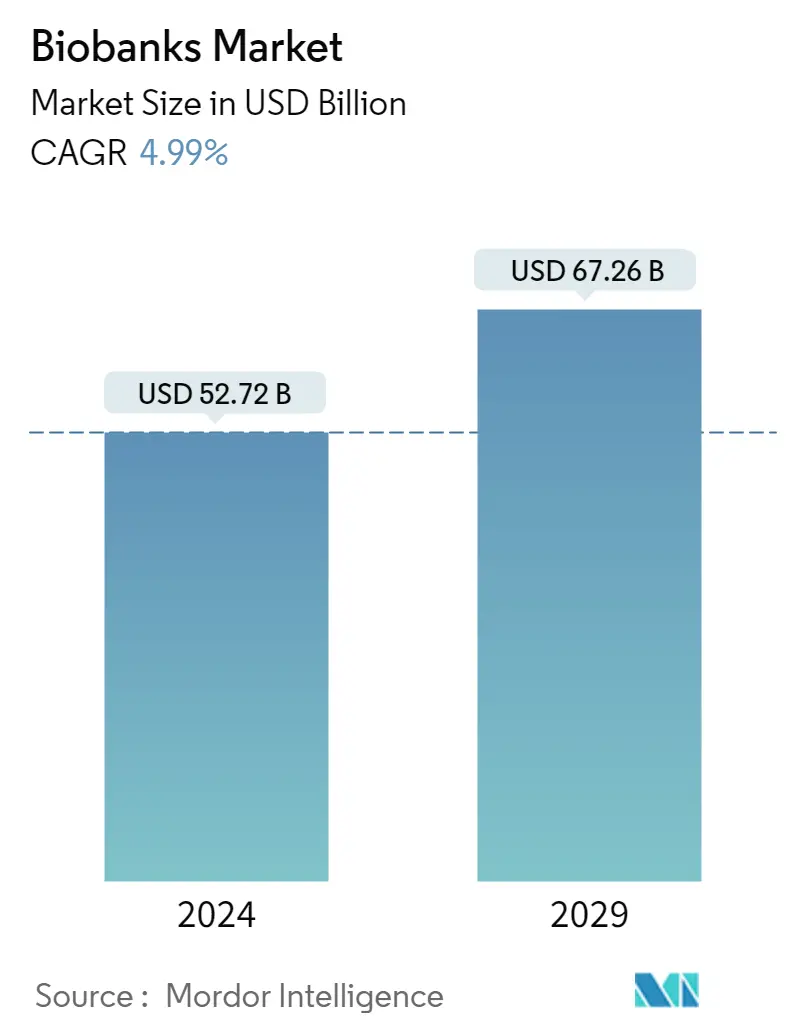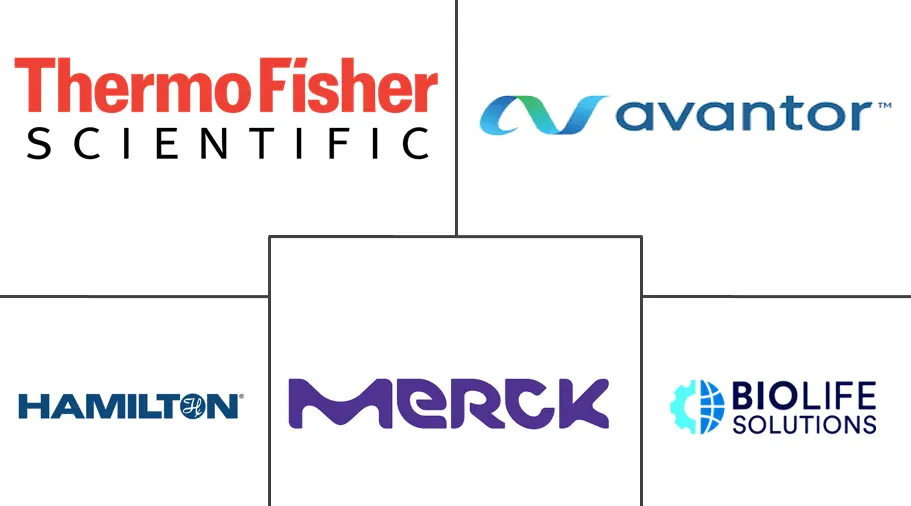Market Size of Biobanks Industry

| Study Period | 2019 - 2029 |
| Market Size (2024) | USD 52.72 Billion |
| Market Size (2029) | USD 67.26 Billion |
| CAGR (2024 - 2029) | 4.99 % |
| Fastest Growing Market | Asia-Pacific |
| Largest Market | North America |
| Market Concentration | Medium |
Major Players
*Disclaimer: Major Players sorted in no particular order |
Biobanking market analysis
The Biobanks Market size is estimated at USD 52.72 billion in 2024, and is expected to reach USD 67.26 billion by 2029, growing at a CAGR of 4.99% during the forecast period (2024-2029).
The COVID-19 pandemic significantly impacted the biobank market. Biobanking plays a critical role in diagnosing and developing treatments for various diseases. There was an urgent need for international efforts to develop vaccines and other therapies to control the COVID-19 pandemic. Patient sample collection, processing, and analysis were at the forefront of this emergency. For instance, according to a July 2021 update by the Government of Ireland, the Minister for Health announced a EUR 2 million (USD 2.18 million) investment in the National Irish COVID-19 Biobank. The National Irish COVID-19 Biobank (NICB) was an essential component of Ireland's response to the COVID-19 pandemic.
Furthermore, as per a February 2021 update, the Sample Collection Database was developed by the SciLifeLab Data Centre in collaboration with Biobank Sweden and the SciLifeLab and KAW National COVID-19 Research Program's Research Area 'Biobanks for COVID-19'. Thus, such initiatives indicated that the onset of the pandemic led to an increased demand for biobank services and benefited the market worldwide. However, the market is currently growing at a stable pace. Due to research and development activity in biotechnology, the market is expected to witness a similar trend over the coming years.
Further, the major factors for the biobank market growth include regenerative medicine innovations, the growing chronic disease incidence, drug discovery and development advances, and R&D funding and investments by government and non-governmental organizations. Innovations in regenerative medicine are driving the market's growth. There was a rising trend of government initiatives and clinical trials associated with stem cell research and promoting regenerative medicine's innovation. For instance, in February 2022, the Indian Council of Medical Research (ICMR) released the National Guidelines for Stem Cell Research (NGSCR) 2017, framed harmoniously with international guidelines. The government supported the ethical and scientific conduct of stem cell research through guidelines for stem cell research. The Department of Biotechnology (DBT) supported projects for the basic biology of stem cells, early and late translational research, developing gene editing technology for potential therapeutic applications, and creating animal models for various human diseases.
Additionally, in July 2021, the NFLA and Sanford Health announced the construction of a biobank to support studies in treating sports-related injuries, brain health, and sports performance in the interest of medical research. The biobank's role in advancing regenerative medicine will help scientists begin their investigations early on and accelerate research, considering active participation from NFLA members. Likewise, in March 2021, the agreements to acquire SSCB Swiss Stem Cells Biotech SA by Gaensel Energy Group Inc. were completed. SSCB permits the preservation of stem cells from adipose tissue, which includes enormous potential in regenerative medicine. Such developments are anticipated to boost the market's growth over the forecast period.
Furthermore, growing R&D funding by government and non-government organizations will bolster the market's growth over the forecast period. For instance, Audubon Bioscience raised nearly USD 220,000 from over 440 investors in 2021 after launching a crowdfunding campaign on MicroVentures.com, an Austin, TX-based online equity crowdfunding platform. The crowdfunding campaign's success demonstrates the growing recognition of biobanking as a critical component of biomedical research advancements.
In addition, in January 2022, the Swedish Childhood Tumor Biobank was allocated SEK 12 million (USD 1.15 million) as a strategic investment for whole-genome sequencing of tumor and blood samples that still need to be analyzed in the sample collection. For 2022, the annual grant increased to SEK 19 million (USD 1.82 million). SEK 24 million (USD 2.30 million) was allocated to the GMS Childhood Cancer Project over three years. Such investments and rising awareness regarding biobanks will likely propel the market's growth throughout the forecast period.
However, regulatory issues and cost constraints are expected to impede the market's growth.
Biobanks Industry Segmentation
As per the scope of the report, a biobank is a biorepository where various biomaterials (usually human specimens) are stored for research purposes. The biobanks market is segmented by equipment (cryogenic storage systems (refrigerators, ice machines, and freezers), alarm monitoring systems, and other equipment), sample type (human tissue biobanking, stem cell biobanking, cord biobanking, DNA/RNA biobanking, and other services), application (regenerative medicine, drug discovery, and disease research), and Geography (North America, Europe, Asia-Pacific, Middle East and Africa, and South America). The market report also covers the estimated market sizes and trends for 17 countries across major regions globally. The report offers the value (in USD) for the above segments.
| By Equipment | |||||
| |||||
| Alarm Monitoring Systems | |||||
| Other Equipment |
| By Sample Type | |
| Human Tissue Biobanking | |
| Stem Cell Biobanking | |
| Cord Banking | |
| DNA/RNA Biobanking | |
| Other Services |
| By Application | |
| Regenerative Medicine | |
| Drug Discovery | |
| Disease Research |
| Geography | ||||||||
| ||||||||
| ||||||||
| ||||||||
| ||||||||
|
Biobanks Market Size Summary
The biobanking market is poised for steady growth, driven by advancements in regenerative medicine, drug discovery, and increased research and development activities. The COVID-19 pandemic underscored the critical role of biobanks in disease diagnosis and treatment development, leading to heightened demand for biobank services globally. Initiatives such as the National Irish COVID-19 Biobank and collaborations like those between SciLifeLab and Biobank Sweden exemplify the sector's responsiveness to urgent health challenges. The market's expansion is further supported by government and non-governmental investments in biotechnology research, as well as strategic developments in stem cell research and regenerative medicine. These efforts are bolstered by guidelines and funding from entities like the Indian Council of Medical Research and the Department of Biotechnology, which promote ethical and scientific advancements in the field.
The human tissue biobanking segment is expected to hold a significant share of the market, fueled by increased research into rare diseases and advancements in regenerative medicine. The acquisition of Tissue Solutions Ltd. by BioIVT and the establishment of new biobanks, such as those by Newcastle University and RareCan, highlight the growing importance of human tissue banking services. North America is anticipated to capture a substantial market share, driven by the rising incidence of chronic diseases and a strong focus on research and development activities. Strategic collaborations and product launches, such as those by Cincinnati Children's Hospital Medical Center and STEMCELL Technologies, further contribute to the market's growth in this region. Despite regulatory challenges and cost constraints, the biobank market remains moderately competitive, with key players like BioLifeSolutions Inc., Hamilton Company, and Thermo Fisher Scientific Inc. leading the charge through partnerships and collaborations.
Biobanks Market Size - Table of Contents
-
1. MARKET DYNAMICS
-
1.1 Market Overview
-
1.2 Market Drivers
-
1.2.1 Innovations in Regenerative Medicine
-
1.2.2 Growing Incidences of Chronic Diseases
-
1.2.3 Advances in Drug Discovery and Development
-
1.2.4 R&D Funding and Investments by Government and Non-Governmental Organizations
-
-
1.3 Market Restraints
-
1.3.1 Regulatory Issues
-
1.3.2 Cost Constraints
-
-
1.4 Porter's Five Forces Analysis
-
1.4.1 Bargaining Power of Suppliers
-
1.4.2 Bargaining Power of Buyers/Consumers
-
1.4.3 Threat of New Entrants
-
1.4.4 Threat of Substitute Products
-
1.4.5 Intensity of Competitive Rivalry
-
-
-
2. MARKET SEGMENTATION (Market Size by Value - USD)
-
2.1 By Equipment
-
2.1.1 Cryogenic Storage Systems
-
2.1.1.1 Refrigerators
-
2.1.1.2 Ice Machines
-
2.1.1.3 Freezers
-
-
2.1.2 Alarm Monitoring Systems
-
2.1.3 Other Equipment
-
-
2.2 By Sample Type
-
2.2.1 Human Tissue Biobanking
-
2.2.2 Stem Cell Biobanking
-
2.2.3 Cord Banking
-
2.2.4 DNA/RNA Biobanking
-
2.2.5 Other Services
-
-
2.3 By Application
-
2.3.1 Regenerative Medicine
-
2.3.2 Drug Discovery
-
2.3.3 Disease Research
-
-
2.4 Geography
-
2.4.1 North America
-
2.4.1.1 United States
-
2.4.1.2 Canada
-
2.4.1.3 Mexico
-
-
2.4.2 Europe
-
2.4.2.1 Germany
-
2.4.2.2 United Kingdom
-
2.4.2.3 France
-
2.4.2.4 Italy
-
2.4.2.5 Spain
-
2.4.2.6 Rest of Europe
-
-
2.4.3 Asia-Pacific
-
2.4.3.1 China
-
2.4.3.2 Japan
-
2.4.3.3 India
-
2.4.3.4 Australia
-
2.4.3.5 South Korea
-
2.4.3.6 Rest of Asia-Pacific
-
-
2.4.4 Middle East and Africa
-
2.4.4.1 GCC
-
2.4.4.2 South Africa
-
2.4.4.3 Rest of Middle East and Africa
-
-
2.4.5 South America
-
2.4.5.1 Brazil
-
2.4.5.2 Argentina
-
2.4.5.3 Rest of South America
-
-
-
Biobanks Market Size FAQs
How big is the Biobanks Market?
The Biobanks Market size is expected to reach USD 52.72 billion in 2024 and grow at a CAGR of 4.99% to reach USD 67.26 billion by 2029.
What is the current Biobanks Market size?
In 2024, the Biobanks Market size is expected to reach USD 52.72 billion.

